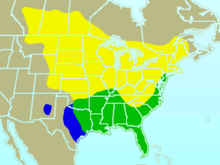
Back دراس بني Arabic دراس بنى ARZ Toxostoma rufum AST Кафява токсостома Bulgarian Risweer rous Breton Mim becut rogenc Catalan Toxostoma rufum CEB Tresglen gynffonhir Welsh Rotspottdrossel German Toxostoma rufum Spanish
| Brown thrasher | |
|---|---|

| |
| Adult in New York, U.S. | |
| Scientific classification | |
| Domain: | Eukaryota |
| Kingdom: | Animalia |
| Phylum: | Chordata |
| Class: | Aves |
| Order: | Passeriformes |
| Family: | Mimidae |
| Genus: | Toxostoma |
| Species: | T. rufum
|
| Binomial name | |
| Toxostoma rufum | |

| |
| Range of T. rufum Breeding range Year-round range Wintering range
| |
| Synonyms | |
The brown thrasher (Toxostoma rufum), sometimes erroneously called the brown thrush or fox-coloured thrush, is a bird in the family Mimidae, which also includes the New World catbirds and mockingbirds. The brown thrasher is abundant throughout the eastern and central United States and southern and central Canada, and it is the only thrasher to live primarily east of the Rockies and central Texas. It is the state bird of Georgia.
As a member of the genus Toxostoma, the bird is relatively large-sized among the other thrashers. It has brown upper parts with a white under part with dark streaks. Because of this, it is often confused with the smaller wood thrush (Hylocichla mustelina), among other species. The brown thrasher is noted for having over 1000 song types, and the largest song repertoire of birds.[3] However, each note is usually repeated in two or three phrases.
The brown thrasher is an omnivore, with its diet ranging from insects to fruits and nuts. The usual nesting areas are shrubs, small trees, or at times on ground level. Brown thrashers are generally inconspicuous but territorial birds, especially when defending their nests, and will attack species as large as humans.[4]
- ^ BirdLife International (2016). "Toxostoma rufum". IUCN Red List of Threatened Species. 2016: e.T22711099A94277500. doi:10.2305/IUCN.UK.2016-3.RLTS.T22711099A94277500.en. Retrieved 3 July 2023.
- ^ Barrows, W.B. (1912). "Brown Thrasher" in Michigan bird life. Michigan Agricultural College. Lansing, Michigan, p. 661.
- ^ Catchpole, Clive K.; J.B. Slater; Peter (2003). Bird Song: Biological Themes and Variations. Cambridge University Press. p. [1]. ISBN 978-0-521-41799-0.
- ^ Brewer, David (2001). Wrens, Dippers and Thrashers. Pica / Christopher Helm. p. 230. ISBN 978-1-873403-95-2.
